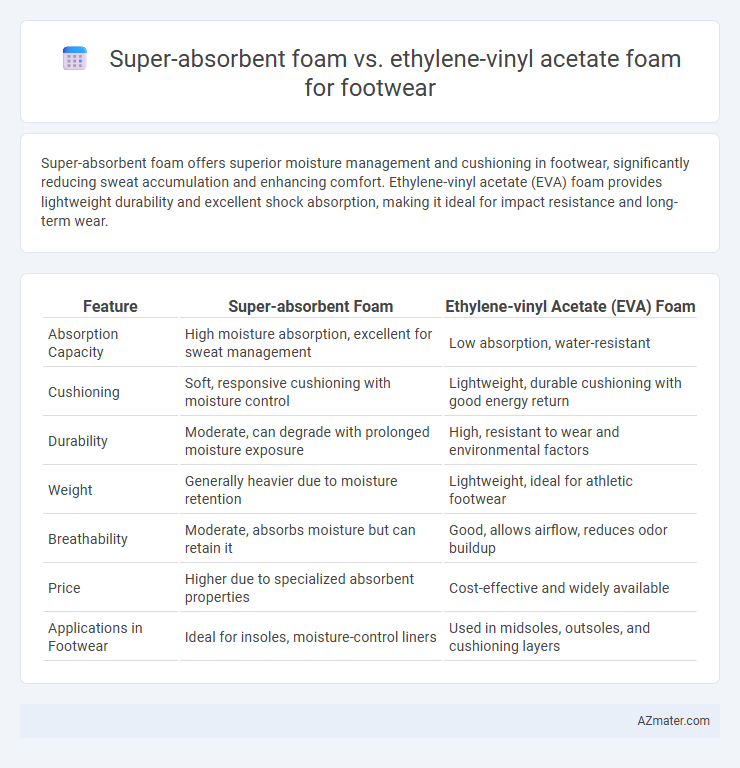Super-absorbent foam offers superior moisture management and cushioning in footwear, significantly reducing sweat accumulation and enhancing comfort. Ethylene-vinyl acetate (EVA) foam provides lightweight durability and excellent shock absorption, making it ideal for impact resistance and long-term wear.
Table of Comparison
| Feature | Super-absorbent Foam | Ethylene-vinyl Acetate (EVA) Foam |
|---|---|---|
| Absorption Capacity | High moisture absorption, excellent for sweat management | Low absorption, water-resistant |
| Cushioning | Soft, responsive cushioning with moisture control | Lightweight, durable cushioning with good energy return |
| Durability | Moderate, can degrade with prolonged moisture exposure | High, resistant to wear and environmental factors |
| Weight | Generally heavier due to moisture retention | Lightweight, ideal for athletic footwear |
| Breathability | Moderate, absorbs moisture but can retain it | Good, allows airflow, reduces odor buildup |
| Price | Higher due to specialized absorbent properties | Cost-effective and widely available |
| Applications in Footwear | Ideal for insoles, moisture-control liners | Used in midsoles, outsoles, and cushioning layers |
Introduction to Foam Technologies in Footwear
Super-absorbent foam in footwear offers exceptional moisture management by rapidly absorbing and locking in sweat, enhancing comfort during prolonged wear. Ethylene-vinyl acetate (EVA) foam provides lightweight cushioning and excellent shock absorption, widely used for midsoles and insoles to improve durability and flexibility. Both foam technologies contribute to advanced footwear design by addressing different aspects of comfort, performance, and moisture control.
What is Super-Absorbent Foam?
Super-absorbent foam is a highly porous and lightweight material designed to absorb and retain large amounts of moisture, making it ideal for footwear applications requiring enhanced sweat management and comfort. This foam typically consists of polymer networks that can quickly wick away sweat from the foot, maintaining a dry and breathable environment inside the shoe. In contrast to ethylene-vinyl acetate foam, super-absorbent foam prioritizes moisture control without compromising cushioning or durability.
Ethylene-Vinyl Acetate (EVA) Foam Explained
Ethylene-vinyl acetate (EVA) foam is widely used in footwear for its lightweight, flexible, and shock-absorbing properties that enhance comfort and durability. Compared to super-absorbent foam, EVA provides excellent cushioning and resilience without retaining moisture, making it ideal for insoles and midsoles in athletic and casual shoes. Its closed-cell structure ensures superior water resistance and long-lasting performance in various environmental conditions.
Cushioning and Comfort: SAE vs. EVA
Super-absorbent foam (SAE) offers superior cushioning in footwear by effectively absorbing and distributing pressure, enhancing comfort during prolonged use and high-impact activities. Ethylene-vinyl acetate (EVA) foam provides a lightweight, flexible cushioning solution with excellent shock absorption, commonly used for its durable resilience and responsiveness in athletic shoes. While SAE excels in moisture management and impact mitigation, EVA remains preferred for its balance of comfort, durability, and cost-efficiency in various footwear applications.
Moisture Management and Breathability Comparison
Super-absorbent foam excels in moisture management by rapidly absorbing and retaining sweat, reducing foot dampness and enhancing comfort during prolonged use. Ethylene-vinyl acetate (EVA) foam offers superior breathability due to its open-cell structure, allowing better air circulation and moisture vapor release, which helps maintain foot dryness. Combining these materials can optimize footwear performance by balancing absorption capacity with ventilation for improved overall foot health.
Durability and Longevity in Daily Use
Super-absorbent foam in footwear offers excellent moisture management, enhancing comfort but may degrade faster under constant compression and exposure to sweat, affecting long-term durability. Ethylene-vinyl acetate (EVA) foam provides superior resilience and retains its cushioning properties over extended daily use, making it a preferred choice for high-impact activities. EVA foam's resistance to cracking and compression set ensures longer lifespan and consistent performance in footwear applications.
Weight and Flexibility Differences
Super-absorbent foam in footwear offers superior moisture management but tends to be heavier compared to ethylene-vinyl acetate (EVA) foam, which is lightweight and enhances overall shoe comfort. EVA foam provides exceptional flexibility, enhancing foot movement and reducing fatigue, while super-absorbent foam is generally less flexible due to its moisture-retaining structure. Choosing between these foams depends on balancing weight and flexibility requirements based on activity type and user preference.
Environmental Impact and Sustainability
Super-absorbent foam in footwear offers superior moisture management but often relies on synthetic polymers that challenge biodegradability and contribute to microplastic pollution, raising environmental concerns. Ethylene-vinyl acetate (EVA) foam, widely used for its lightweight cushioning, has a relatively lower carbon footprint when produced with bio-based EVA variants and can be recycled more effectively in closed-loop systems. Sustainable innovation in EVA focuses on increasing bio-content and enhancing recyclability, whereas super-absorbent foams require breakthroughs in biodegradable polymer chemistry to reduce their environmental impact.
Cost Considerations for Manufacturers and Consumers
Super-absorbent foam generally incurs higher production costs due to advanced polymer technology and water-absorbing additives, affecting both manufacturing expenses and retail prices. Ethylene-vinyl acetate (EVA) foam offers a cost-effective alternative with lower raw material costs and simpler processing, making it attractive for budget-conscious manufacturers and consumers. The choice between these materials significantly impacts overall footwear pricing strategies, balancing performance benefits against cost efficiency.
Choosing the Best Foam for Your Footwear Needs
Super-absorbent foam excels in moisture management by absorbing sweat and maintaining foot dryness, making it ideal for athletic and high-performance footwear. Ethylene-vinyl acetate (EVA) foam offers superior cushioning, lightweight comfort, and durability, preferred in casual and everyday shoes. Selecting the best foam depends on activity level and foot support requirements, with super-absorbent foam suited for moisture control and EVA foam optimized for shock absorption and long-lasting wear.

Infographic: Super-absorbent foam vs Ethylene-vinyl acetate foam for Footwear
 azmater.com
azmater.com